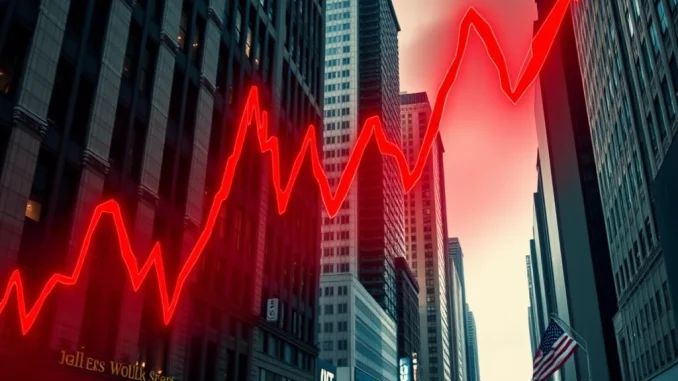
Buckle up, investors! The opening bell on Wall Street just rang, and it’s echoing with a distinctly bearish tone. The U.S. stock markets have commenced trading today with a significant downturn, painting the screens red across the board. If you’re keeping an eye on your investments, especially in the volatile world of cryptocurrency which often mirrors traditional market sentiment, this morning’s trading session demands your attention. Let’s dive into what’s happening and what it might mean for you.
Why Did the Stock Market Open Lower Today?
The question on everyone’s mind is, what triggered this morning’s slide? While the day is still young and the full picture will unfold as trading progresses, several factors are likely contributing to this initial market downturn. Economic indicators, global events, and investor sentiment all play a crucial role in shaping market direction. It’s a complex interplay, but here are a few potential drivers:
- Inflation Concerns: Persistent inflation remains a major headwind. Investors are keenly watching for signals from the Federal Reserve regarding future interest rate hikes, which can dampen economic growth and corporate earnings. Any hint of more aggressive tightening could trigger market jitters.
- Geopolitical Uncertainty: Global events always cast a shadow over the markets. Ongoing geopolitical tensions and uncertainties can create risk aversion, leading investors to pull back from equities and seek safer havens.
- Earnings Season Expectations: As we navigate through earnings season, the market’s reaction to corporate results is amplified. If investors anticipate weaker-than-expected earnings or cautious guidance from major companies, it can fuel a negative sentiment right from the stock market open lower.
- Profit Taking: After periods of market gains, some investors may decide to lock in profits, especially if they foresee potential headwinds. This can contribute to initial selling pressure at the market open lower.
Breaking Down the Key Indices: S&P 500, NASDAQ, and Dow Jones
Let’s take a closer look at the performance of the three major U.S. stock market indices to understand the breadth and depth of this morning’s decline:
| Index | Percentage Change | What it Represents |
|---|---|---|
| S&P 500 | -1.9% | Considered the benchmark for the U.S. stock market, the S&P 500 tracks 500 of the largest publicly traded companies in the United States. A 1.9% drop is a significant move, indicating broad-based selling pressure across various sectors. This decline in the S&P 500 signals a widespread negative sentiment among investors. |
| NASDAQ Composite | -2.71% | The NASDAQ Composite is heavily weighted towards technology stocks. A steeper fall of -2.71% in the NASDAQ suggests that tech stocks are facing even greater pressure. This could be due to concerns about growth prospects in the tech sector, higher interest rates impacting growth stock valuations, or sector-specific news. |
| Dow Jones Industrial Average (Dow) | -1.51% | The Dow Jones, comprising 30 large, established U.S. companies, is often seen as a barometer of blue-chip stock performance. A -1.51% drop in the Dow Jones, while slightly less severe than the NASDAQ, still reflects a substantial downturn and indicates that even established companies are not immune to the current market pressures. |
These numbers paint a clear picture: all major segments of the U.S. stock market are experiencing a significant pullback at the stock market open lower.
What Does This Mean for Cryptocurrency Investors?
While the stock market and cryptocurrency markets are distinct, they are increasingly interconnected. Here’s why this market downturn in traditional equities might be relevant to those in the crypto space:
- Risk Sentiment Correlation: Both stock and crypto markets are influenced by overall risk sentiment. When investors become risk-averse, they tend to reduce exposure to both equities and cryptocurrencies. A ‘risk-off’ mood in the stock market can often spill over into the crypto market, leading to similar downward pressure.
- Macroeconomic Factors: Factors driving the stock market decline, such as inflation and interest rate hikes, also impact the broader macroeconomic environment, which in turn affects crypto. For instance, rising interest rates can make riskier assets like crypto less attractive compared to safer, yield-bearing investments.
- Institutional Investment: As institutional investment in crypto grows, the correlation between traditional and crypto markets is likely to strengthen. Institutions often manage portfolios across both asset classes, and their investment decisions can create interconnected movements.
- Market Psychology: News of a significant stock market open lower can influence overall market psychology. Negative headlines can create a sense of unease and uncertainty, prompting investors across all markets, including crypto, to become more cautious.
Navigating the Downturn: Actionable Insights
So, what should investors do in response to this market downturn? Here are a few actionable insights:
- Stay Informed: Keep a close watch on market developments throughout the day. Monitor news sources for updates on economic data, corporate earnings, and geopolitical events that could be influencing market direction.
- Review Your Portfolio: Assess your portfolio’s risk exposure. Consider whether your asset allocation aligns with your risk tolerance, especially in light of increased market volatility.
- Avoid Panic Selling: Market downturns can be unsettling, but impulsive decisions driven by fear can be detrimental. Avoid panic selling and stick to your long-term investment strategy.
- Consider Dollar-Cost Averaging: For long-term investors, market dips can present opportunities to buy assets at lower prices. Dollar-cost averaging, investing a fixed amount regularly, can be a strategy to navigate volatility.
- Diversification: A well-diversified portfolio across different asset classes can help mitigate risk during market downturns. Ensure your portfolio is not overly concentrated in any single asset class.
Conclusion: Weathering the Storm
The U.S. stock markets have started the day on a negative note, reflecting broader market anxieties. While the initial stock market open lower is concerning, it’s crucial to remember that market fluctuations are a normal part of the investment cycle. By staying informed, maintaining a disciplined approach, and focusing on long-term goals, investors can navigate these turbulent times and position themselves for future opportunities. The market’s reaction throughout the day and in the coming days will provide further clarity. Stay tuned for more updates and analysis as the situation unfolds.



